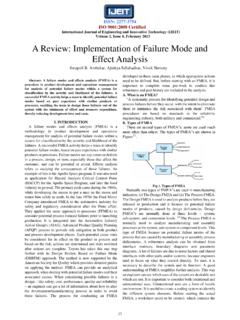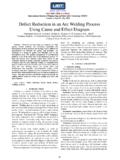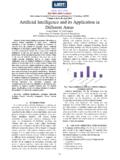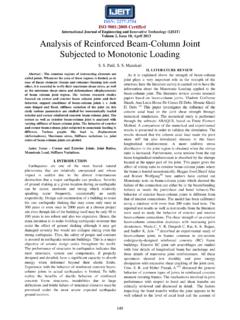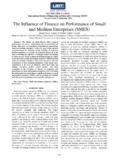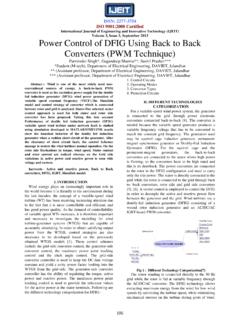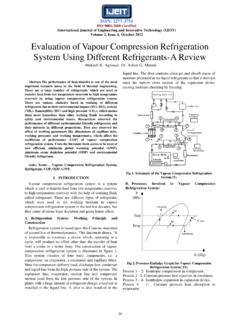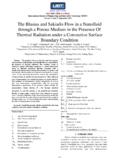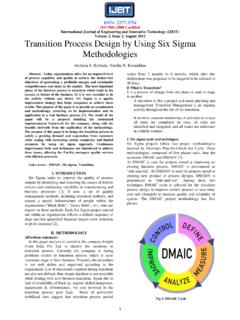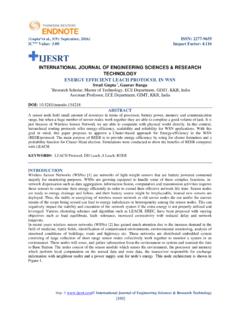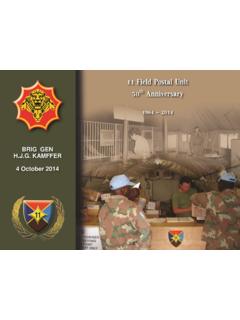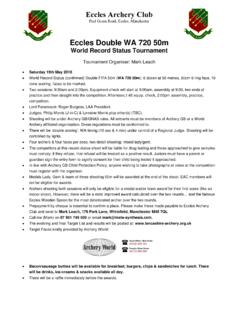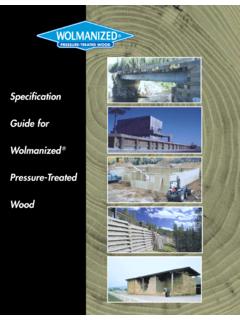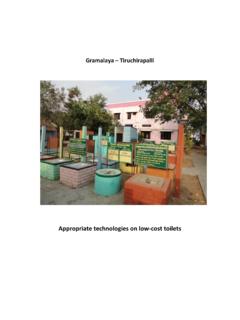Transcription of Improved Cluster Head Selection Using Enhanced …
1 ISSN: 2277-3754 ISO 9001:2008 Certified International Journal of Engineering and Innovative Technology (IJEIT) Volume 3, Issue 3, September 2013 77 Improved Cluster Head Selection Using Enhanced LEACH Protocol Nikita Sehgal, Gurwinder Kaur Department of Electronics and Communication Engineering Yadavindra College of Engineering (YCoE) Punjabi University Guru Kashi Campus, Talwandi Sabo, District Bathinda, Punjab, India Abstract Routing in Wireless Sensor Network (WSN) is an important area of research due to its rapidly increasing application in monitoring various kinds of environment by sensing physical phenomenon.
2 It introduces an energy efficient clustering algorithm for WSN based on Low Energy Adaptive Clustering Hierarchy (LEACH) which will remove some of the drawbacks of LEACH. It utilizes the remaining energy of the current Cluster Head (CH) to make the routing process more efficient. In heterogeneous sensor networks, some nodes become Cluster heads which aggregate the data of their Cluster nodes and transmit it to the sink. Improved hierarchical clustered heterogeneous network has been proposed where the advanced nodes elect themselves as Cluster heads for the increasing number of rounds based on their higher initial energy relative to other nodes.
3 Proposed algorithm is designed and implemented in MATLAB. It is shown that the proposed algorithm provides better results than existing, as we have extended the stability time or when the first node dead time. Also last node dead or network lifetime is also increased. Proposed algorithm has also increased the throughput of the wireless sensor network. Index Terms WSN, Advance Nodes, Energy Consumption, Dead Nodes I. INTRODUCTION A wireless sensor network consists of a large number of sensor nodes and a base station that serves as a gateway to some other networks. Sensor node senses their environment, collect sensed data and transmit to the base station.
4 It is a network which is wireless and deals with sensors. It consists of nodes that communicates with each other through wireless links sensors that are remotely deployed in large numbers and operates environments. A Wireless Sensor Networks (WSN) includes spatially distributed sensors to cooperatively monitor various environmental conditions, which includes temperature, sound, vibration, pressure, motion or pollutants. It consists of a large number of nodes with a limited energy supply. Wireless Sensor Network (WSN) is an advanced intelligent network which is organized by amounts of functional sensor nodes.
5 The sensor nodes in Wireless Sensor Network can transmit information and cooperate with each other to accomplish some special functions through implementing the self-organization wireless communication manner. In addition, Wireless Sensor Network can be widely applied in the following areas, such as military, industry, agriculture, medical and environmental monitoring area [6] .To reduce the consumption of energy, the network routing protocol is regarded as a new direction being researched for the energy-constrained wireless sensor network. As a result, the routing protocol can reduce communication volume and save network energy.
6 Low Energy Adaptive Clustering Hierarchy (LEACH) is the first implemented Cluster -based routing protocol and it is also considered as the base of other Cluster routing protocols. II. VARIOUS HIERARCHICAL ROUTING PROTOCOLS The main objective of hierarchical routing is to maintain the energy consumption of various sensor nodes by involving them in multi-hop communication within a particular Cluster and by performing data aggregation and fusion in order to decrease the number of transmitted messages to the sink. Cluster formation is typically based on the energy reserve of sensors and sensor s proximity to the Cluster head.
7 LEACH is one of the first hierarchical routing approaches for sensors networks. The idea proposed in LEACH has been an inspiration for many hierarchical routing protocols, although some protocols have been independently developed. We explore hierarchical routing protocols in this section. A. LEACH Low Energy Adaptive Clustering Hierarchy (LEACH) is the first hierarchical Cluster -based routing protocol for wireless sensor network which partitions the nodes into clusters, in each Cluster a dedicated node with extra privileges called Cluster Head (CH) is responsible for creating and manipulating a TDMA (Time division multiple access) schedule and sending aggregated data from nodes to the BS where these data is needed Using CDMA (Code division multiple access).
8 Remaining nodes are Cluster members [8]. Architecture of LEACH The operation of LEACH protocol is broken into rounds. Each round begins with setup phase, during which clusters formation takes place and steady phase during which data is being transferred to base station. Steady phase is usually longer than set up phase. Initially at the beginning of each round, each node decides whether it has to be CH or not. The node which decides to be Cluster head sends a message. All other nodes other than the CH will keep their receiver on and decide to which CH they need to join [3].
9 Every node selects a Cluster head which is close to it. All nodes send messages to their respective Cluster heads . The CH based on the number of requesting node creates a proper TDMA ISSN: 2277-3754 ISO 9001:2008 Certified International Journal of Engineering and Innovative Technology (IJEIT) Volume 3, Issue 3, September 2013 78 schedule for all the nodes. Only during their respective schedules nodes interact with the CH, else the nodes will go to sleep mode. The Cluster heads obtains data from all nodes in its Cluster , further aggregates the data and finally sends it to the base station.
10 The phase after the schedule has been announced, is called the steady phase and phase before schedule is announced, is referred as setup phase. After the steady phase next round start Each node independent of other nodes decides whether it will selected as a CH or not. This decision made takes into account when the node served as a CH for the last time (the node that has not been a CH for long time has more probability to elect itself than nodes that has been a CH recently) [6]. In the following advertisement phase, the CHs inform their neighborhood with an advertisement packet that they become CHs.
